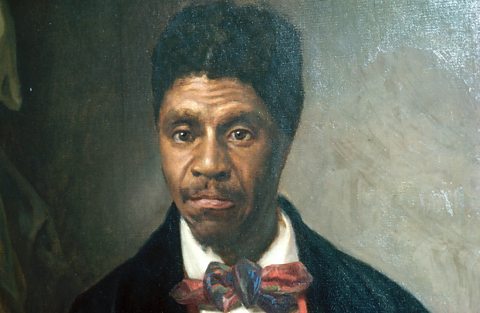Relations between slave and non-slave States
The Missouri Compromise of 1820 kept an uneasy alliance for many years between the North and South. However, when California became a state further compromise had to be created.
The 1850 Compromise
After the 1846 war with Mexico, vast areas of land were handed to the USA.
In 1849 California applied for admission as a free stateA state in North America which did not support slavery during the 19th century.. However it fell in the middle of the latitude 36°30′ northA circle of latitude which was used to divide the prospective slave and free states west of the Mississippi River, with the exception of Missouri.. Another compromise had to be worked out.
- California became a free state
- the new lands taken from Mexico were organised as
territories
– not yet states - a new fugitive slave law (giving enslaved people who had escaped to Northern free states back to the South) was made. This made the South happy
Other tensions between the North and South started to appear.
Kansas Nebraska Act 1854
The Democrat politician Stephen Douglas had the idea that the new territories of Kansas and Nebraska would choose for themselves whether they would become slave or free states. This meant the old Missouri Compromise was no longer legal.
- Southerners loved the idea
- Northerners hated it
- Kansas and Nebraska became a battle ground
- Anti-slavery leaders formed the Republican Party with the political aim of opposing slavery
The Dred Scott Case 1857

Dred Scott was an enslaved people who had lived with his "owner" in a free state before returning to the slave state of Missouri. He believed that, as he had lived in a free state, he was a free man. He went to the Supreme Court to prove this:
- he lost the case
- he was not seen as a person but as a piece of property
- banning slavery above the latitude 36°30′ northA circle of latitude which was used to divide the prospective slave and free states west of the Mississippi River, with the exception of Missouri. was now illegal as it would deprive a person of their property
- the new territories were now open to slavery and only an individual state could prevent it
John Brown's raid on Harpers Ferry, 1859
John Brown was an abolitionist. He led a small group in an attempt to capture a government arsenalGun and weapon store. in Harpers Ferry, Virginia. He was going to use the guns to arm a rebellion of enslaved people.
- the raid failed and John Brown was executed
- the South saw this as a sign of what would happen if the Republicans came to power
- the South thought Northerners would be willing to use violence to end slavery
- most Northerners actually condemned the raid